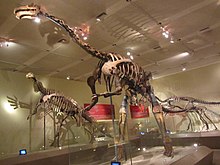Suzhousaurus
| Suzhousaurus | |
|---|---|

| |
| Mounted skeleton displayed in National Museum of Natural Science with elements from both specimens | |
| Scientific classification | |
| Domain: | Eukaryota |
| Kingdom: | Animalia |
| Phylum: | Chordata |
| Clade: | Dinosauria |
| Clade: | Saurischia |
| Clade: | Theropoda |
| Clade: | †Therizinosauria |
| Superfamily: | † Therizinosauroidea
|
| Genus: | †Suzhousaurus Li et al. 2007 |
| Type species | |
| †Suzhousaurus megatherioides Li et al. 2007
| |
Suzhousaurus (meaning "Suzhou lizard") is a
Suzhousaurus was an unusually large Early Cretaceous therizinosauroid reaching lengths of 6 m (20 ft) and nearly 3.1 t (3,100 kg) in weight. The upper arm (
With the description of the more complete second specimen, the
History of discovery

The
In 2008, a new and fairly more complete skeleton was described. The specimen FRDC-GSJB-2004-001 which contains the last three dorsal vertebrae, the
In 2018, You with colleagues proposed the Mazongshan Fauna, which is composed by dinosaur taxa found on the Xiagou and Zhonggou formations, and provided more historical data from the Suzhousaurus specimens: FRDC-GSJB-99 was discovered around 1999 being found in mid gray-variegated beds of the Xiagou Formation dating to the early–mid-Aptian stage, and FRDC-GSJB-2004-001 was found in 2004 at the upper red beds in the Zhonggou Formation dating to the Early Albian.[5]
Description

Suzhousaurus was one of the largest known Early Cretaceous therizinosauroids, with a length of 6 m (20 ft) and a ponderous weight of approximately 3.1 t (3,100 kg).
The

As a whole, the
Classification
Li and coauthors, in their description, assigned Suzhousaurus to the

Results obtained by Zanno in 2010 for the Therizinosauroidea are shown in the cladogram below:[8]
Therizinosauroidea
|
|
Paleoecology
The overall environment deposition of the
Xiagou Formation

The gray-variegated beds in the Xiagou Formation of the Yujingzi Basin were deposited in
Zhonggou Formation
The Albian Zhonggou Formation slightly overlains the
See also
References
- ^ ISSN 1000-9515.
- ^ doi:10.1139/E08-021.
- ^ Button, K.; Zanno, L. E.; You, H.; Kirkland, J. I. (2015). "Dichotomous evolution of tooth growth and replacement strategies in herbivorous dinosaurs". Journal of Vertebrate Paleontology, SVP Program and Abstracts Book (2015): 100.
- ^ PMID 29250467.
- ^ S2CID 202867591.
- PMID 24802911.
- ISBN 9780691167664.
- ^ S2CID 53405097.
- S2CID 204993327.
- PMID 23734177.
- PMID 31333906.
- PMID 24147058.
